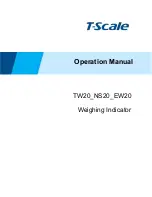
1 - 2
BeneVision TM80 Telemetry Monitor Operator’s Manual
•
Do not expose the equipment to a Magnetic Resonance (MR) environment.
◆
Thermal injury and burns may occur due to the metal components of the
equipment which can heat during MR scanning.
◆
The equipment may present a risk of projectile injury due to the presence of
ferromagnetic materials which can be attracted by the MR magnet core.
◆
The leadwires and electrodes will generate artifacts in the MR image.
◆
The equipment will not function properly due to the strong magnetic and
radio frequency fields generated by the MR scanner.
•
Before putting the telemetry monitor into operation, the operator must verify
that the equipment, connecting cables and accessories are in correct working
order and operating condition.
•
Do not use patient cables or accessory cables and sensors if prior visual
inspection reveals cable damage or the presence of liquid, lint or dust inside.
•
Do not come into contact with the patient during defibrillation. Otherwise
serious injury or death could result.
•
Do not touch the patient and live parts simultaneously.
•
Do not open the equipment housings. All servicing and future upgrades must
be carried out by trained and authorized personnel.
•
Do not rely exclusively on the audible alarm system for patient monitoring.
Adjustment of alarm volume to a low level may result in a hazard to the patient.
Always keep the patient under close surveillance.
•
The physiological data and alarm messages displayed on the telemetry monitor
are for reference only and cannot be directly used for diagnostic interpretation.
•
PATIENTS WITH A PACEMAKER – On ventricular paced patients, episodes of
ventricular tachycardia may not always be detected. Do not rely entirely upon
the system’s automated arrhythmia detection algorithm. Keep pacemaker
patients under close surveillance.
•
Do not operate the touch screen with wet hand.
•
Only use parts and accessories specified in this manual.
•
Route, wrap and secure the cables to avoid inadvertent disconnection,
stumbling and entanglement.
•
Instruct patients not to interact with the display of the telemetry monitor and
not to open the battery compartment while the telemetry monitor is in use.
•
The telemetry monitor should not be used for primary monitoring in
applications where momentary loss of the ECG is unacceptable at the Central
Monitoring System.
•
We recommend that the WPA2-PSK or WPA2 CCKM security mode be used when
the telemetry monitor is in use.
Summary of Contents for TM80
Page 1: ...BeneVision TM80 Telemetry Monitor Operator s Manual...
Page 2: ......
Page 20: ...1 6 BeneVision TM80 Telemetry Monitor Operator s Manual This page intentionally left blank...
Page 29: ...BeneVision TM80 Telemetry Monitor Operator s Manual 2 9...
Page 30: ...2 10 BeneVision TM80 Telemetry Monitor Operator s Manual This page intentionally left blank...
Page 46: ...3 16 BeneVision TM80 Telemetry Monitor Operator s Manual This page intentionally left blank...
Page 50: ...4 4 BeneVision TM80 Telemetry Monitor Operator s Manual This page intentionally left blank...
Page 56: ...5 6 BeneVision TM80 Telemetry Monitor Operator s Manual This page intentionally left blank...
Page 66: ...6 10 BeneVision TM80 Telemetry Monitor Operator s Manual This page intentionally left blank...
Page 136: ...11 8 BeneVision TM80 Telemetry Monitor Operator s Manual This page intentionally left blank...
Page 174: ...14 8 BeneVision TM80 Telemetry Monitor Operator s Manual This page intentionally left blank...
Page 192: ...15 18 BeneVision TM80 Telemetry Monitor Operator s Manual This page intentionally left blank...
Page 200: ...16 8 BeneVision TM80 Telemetry Monitor Operator s Manual This page intentionally left blank...
Page 206: ...17 6 BeneVision TM80 Telemetry Monitor Operator s Manual This page intentionally left blank...
Page 238: ...D 4 BeneVision TM80 Telemetry Monitor Operator s Manual This page intentionally left blank...
Page 239: ......
Page 240: ...P N 046 012662 00 6 0...
















































